display HUMMER H2 2008 Owners Manual
[x] Cancel search | Manufacturer: HUMMER, Model Year: 2008, Model line: H2, Model: HUMMER H2 2008Pages: 504, PDF Size: 7.12 MB
Page 12 of 504
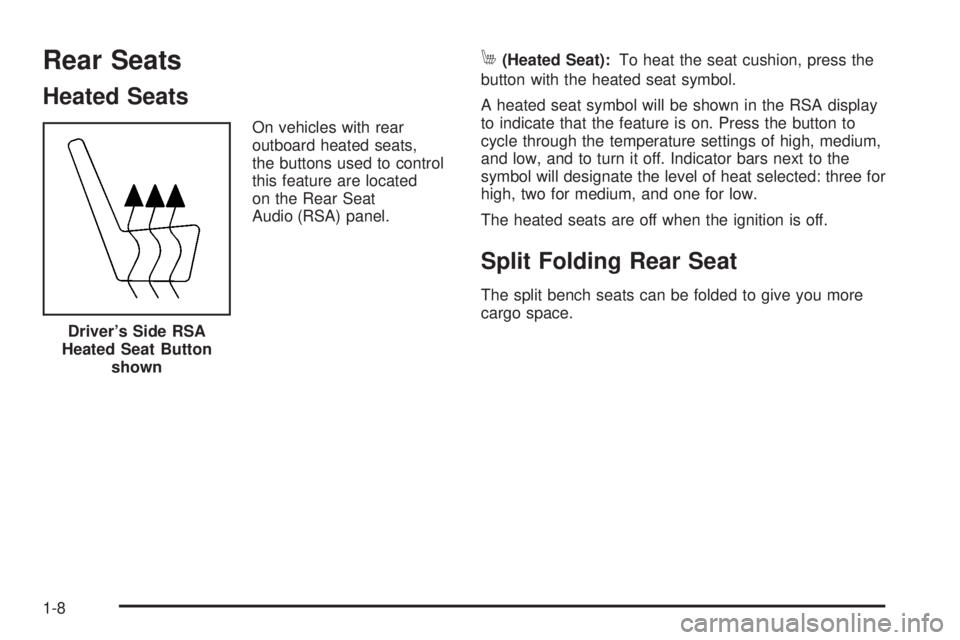
Rear Seats
Heated Seats
On vehicles with rear
outboard heated seats,
the buttons used to control
this feature are located
on the Rear Seat
Audio (RSA) panel.
M(Heated Seat):To heat the seat cushion, press the
button with the heated seat symbol.
A heated seat symbol will be shown in the RSA display
to indicate that the feature is on. Press the button to
cycle through the temperature settings of high, medium,
and low, and to turn it off. Indicator bars next to the
symbol will designate the level of heat selected: three for
high, two for medium, and one for low.
The heated seats are off when the ignition is off.
Split Folding Rear Seat
The split bench seats can be folded to give you more
cargo space.
Driver’s Side RSA
Heated Seat Button
shown
1-8
Page 83 of 504
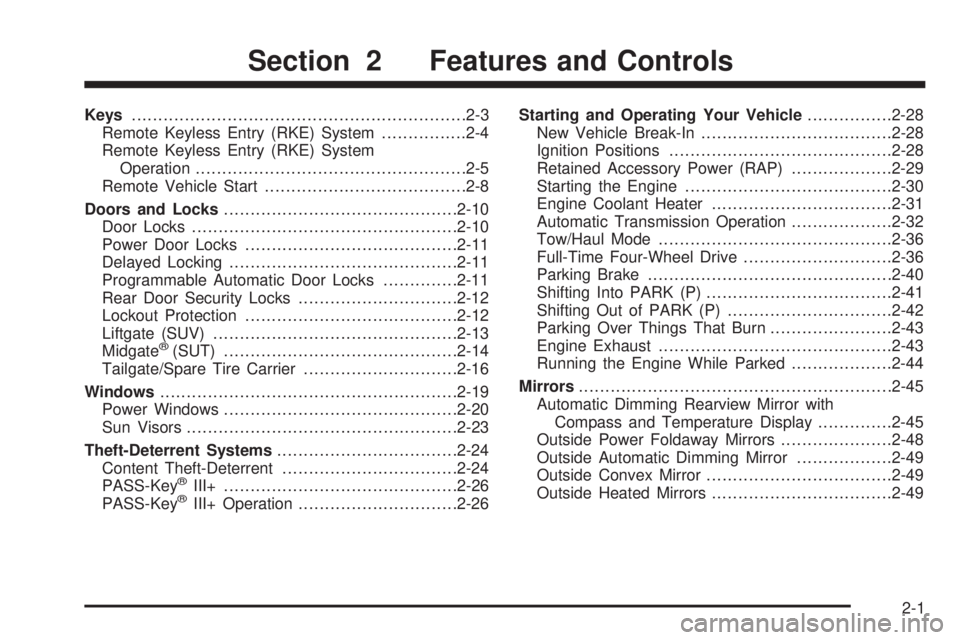
Keys...............................................................2-3
Remote Keyless Entry (RKE) System................2-4
Remote Keyless Entry (RKE) System
Operation...................................................2-5
Remote Vehicle Start......................................2-8
Doors and Locks............................................2-10
Door Locks..................................................2-10
Power Door Locks........................................2-11
Delayed Locking...........................................2-11
Programmable Automatic Door Locks..............2-11
Rear Door Security Locks..............................2-12
Lockout Protection........................................2-12
Liftgate (SUV)..............................................2-13
Midgate
®(SUT)............................................2-14
Tailgate/Spare Tire Carrier.............................2-16
Windows........................................................2-19
Power Windows............................................2-20
Sun Visors...................................................2-23
Theft-Deterrent Systems..................................2-24
Content Theft-Deterrent.................................2-24
PASS-Key
®III+............................................2-26
PASS-Key®III+ Operation..............................2-26Starting and Operating Your Vehicle................2-28
New Vehicle Break-In....................................2-28
Ignition Positions..........................................2-28
Retained Accessory Power (RAP)...................2-29
Starting the Engine.......................................2-30
Engine Coolant Heater..................................2-31
Automatic Transmission Operation...................2-32
Tow/Haul Mode............................................2-36
Full-Time Four-Wheel Drive............................2-36
Parking Brake..............................................2-40
Shifting Into PARK (P)...................................2-41
Shifting Out of PARK (P)...............................2-42
Parking Over Things That Burn.......................2-43
Engine Exhaust............................................2-43
Running the Engine While Parked...................2-44
Mirrors...........................................................2-45
Automatic Dimming Rearview Mirror with
Compass and Temperature Display..............2-45
Outside Power Foldaway Mirrors.....................2-48
Outside Automatic Dimming Mirror..................2-49
Outside Convex Mirror...................................2-49
Outside Heated Mirrors..................................2-49
Section 2 Features and Controls
2-1
Page 89 of 504
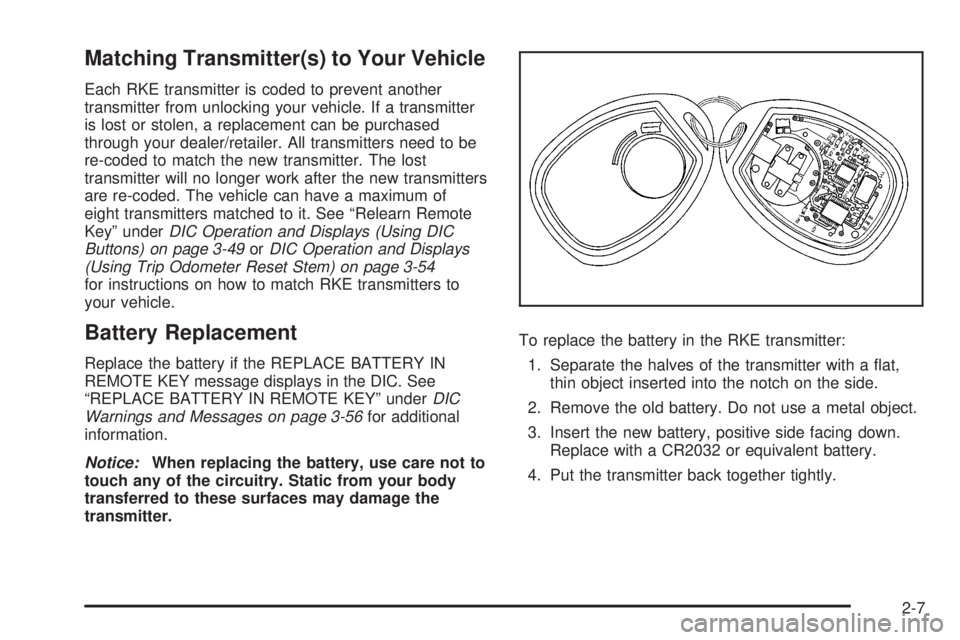
Matching Transmitter(s) to Your Vehicle
Each RKE transmitter is coded to prevent another
transmitter from unlocking your vehicle. If a transmitter
is lost or stolen, a replacement can be purchased
through your dealer/retailer. All transmitters need to be
re-coded to match the new transmitter. The lost
transmitter will no longer work after the new transmitters
are re-coded. The vehicle can have a maximum of
eight transmitters matched to it. See “Relearn Remote
Key” underDIC Operation and Displays (Using DIC
Buttons) on page 3-49orDIC Operation and Displays
(Using Trip Odometer Reset Stem) on page 3-54
for instructions on how to match RKE transmitters to
your vehicle.
Battery Replacement
Replace the battery if the REPLACE BATTERY IN
REMOTE KEY message displays in the DIC. See
“REPLACE BATTERY IN REMOTE KEY” underDIC
Warnings and Messages on page 3-56for additional
information.
Notice:When replacing the battery, use care not to
touch any of the circuitry. Static from your body
transferred to these surfaces may damage the
transmitter.To replace the battery in the RKE transmitter:
1. Separate the halves of the transmitter with a �at,
thin object inserted into the notch on the side.
2. Remove the old battery. Do not use a metal object.
3. Insert the new battery, positive side facing down.
Replace with a CR2032 or equivalent battery.
4. Put the transmitter back together tightly.
2-7
Page 114 of 504
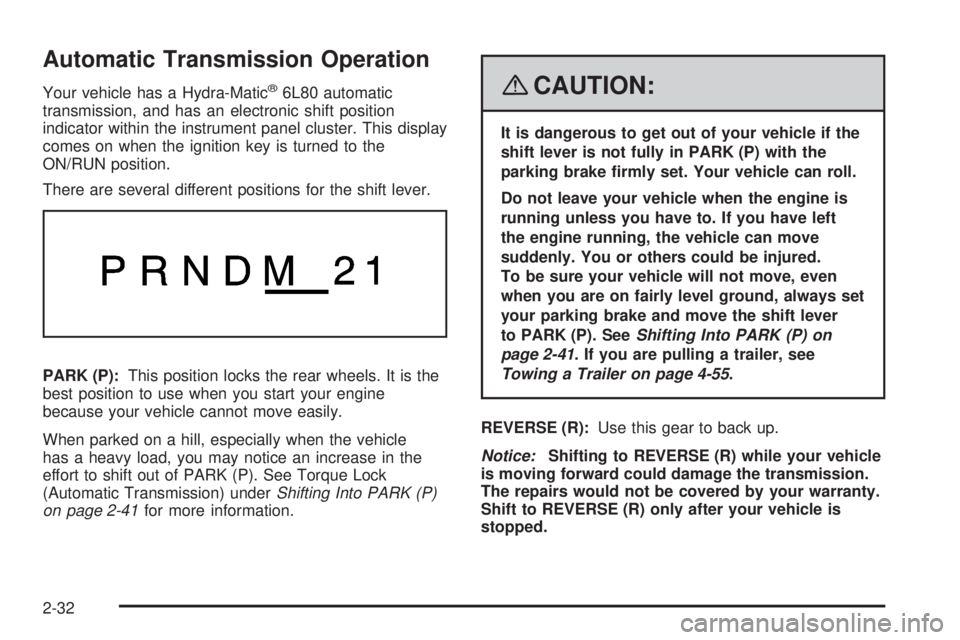
Automatic Transmission Operation
Your vehicle has a Hydra-Matic®6L80 automatic
transmission, and has an electronic shift position
indicator within the instrument panel cluster. This display
comes on when the ignition key is turned to the
ON/RUN position.
There are several different positions for the shift lever.
PARK (P):This position locks the rear wheels. It is the
best position to use when you start your engine
because your vehicle cannot move easily.
When parked on a hill, especially when the vehicle
has a heavy load, you may notice an increase in the
effort to shift out of PARK (P). See Torque Lock
(Automatic Transmission) underShifting Into PARK (P)
on page 2-41for more information.{CAUTION:
It is dangerous to get out of your vehicle if the
shift lever is not fully in PARK (P) with the
parking brake �rmly set. Your vehicle can roll.
Do not leave your vehicle when the engine is
running unless you have to. If you have left
the engine running, the vehicle can move
suddenly. You or others could be injured.
To be sure your vehicle will not move, even
when you are on fairly level ground, always set
your parking brake and move the shift lever
to PARK (P). SeeShifting Into PARK (P) on
page 2-41. If you are pulling a trailer, see
Towing a Trailer on page 4-55.
REVERSE (R):Use this gear to back up.
Notice:Shifting to REVERSE (R) while your vehicle
is moving forward could damage the transmission.
The repairs would not be covered by your warranty.
Shift to REVERSE (R) only after your vehicle is
stopped.
2-32
Page 117 of 504
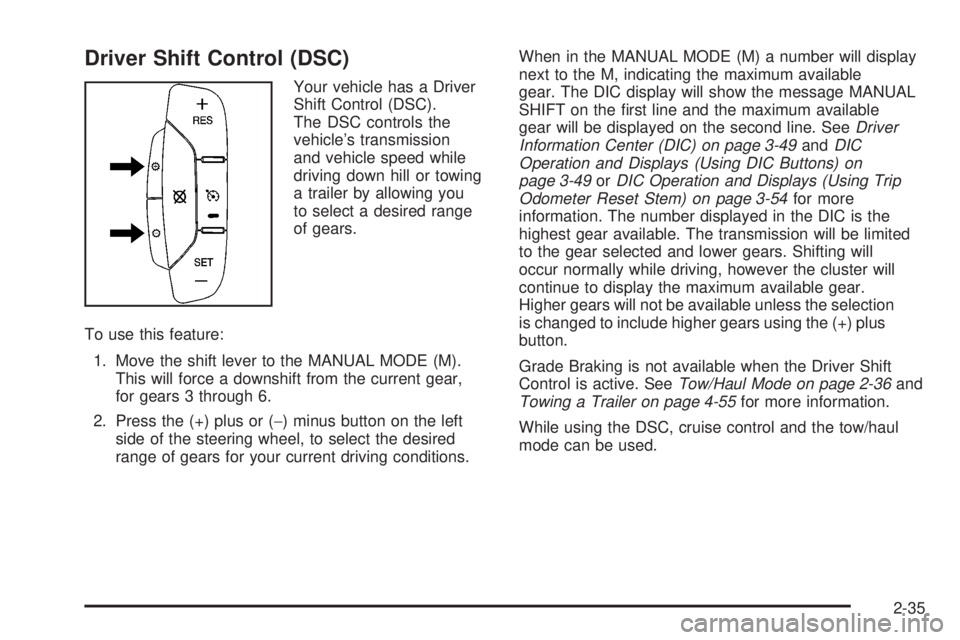
Driver Shift Control (DSC)
Your vehicle has a Driver
Shift Control (DSC).
The DSC controls the
vehicle’s transmission
and vehicle speed while
driving down hill or towing
a trailer by allowing you
to select a desired range
of gears.
To use this feature:
1. Move the shift lever to the MANUAL MODE (M).
This will force a downshift from the current gear,
for gears 3 through 6.
2. Press the (+) plus or (−) minus button on the left
side of the steering wheel, to select the desired
range of gears for your current driving conditions.When in the MANUAL MODE (M) a number will display
next to the M, indicating the maximum available
gear. The DIC display will show the message MANUAL
SHIFT on the �rst line and the maximum available
gear will be displayed on the second line. SeeDriver
Information Center (DIC) on page 3-49andDIC
Operation and Displays (Using DIC Buttons) on
page 3-49orDIC Operation and Displays (Using Trip
Odometer Reset Stem) on page 3-54for more
information. The number displayed in the DIC is the
highest gear available. The transmission will be limited
to the gear selected and lower gears. Shifting will
occur normally while driving, however the cluster will
continue to display the maximum available gear.
Higher gears will not be available unless the selection
is changed to include higher gears using the (+) plus
button.
Grade Braking is not available when the Driver Shift
Control is active. SeeTow/Haul Mode on page 2-36and
Towing a Trailer on page 4-55for more information.
While using the DSC, cruise control and the tow/haul
mode can be used.
2-35
Page 127 of 504
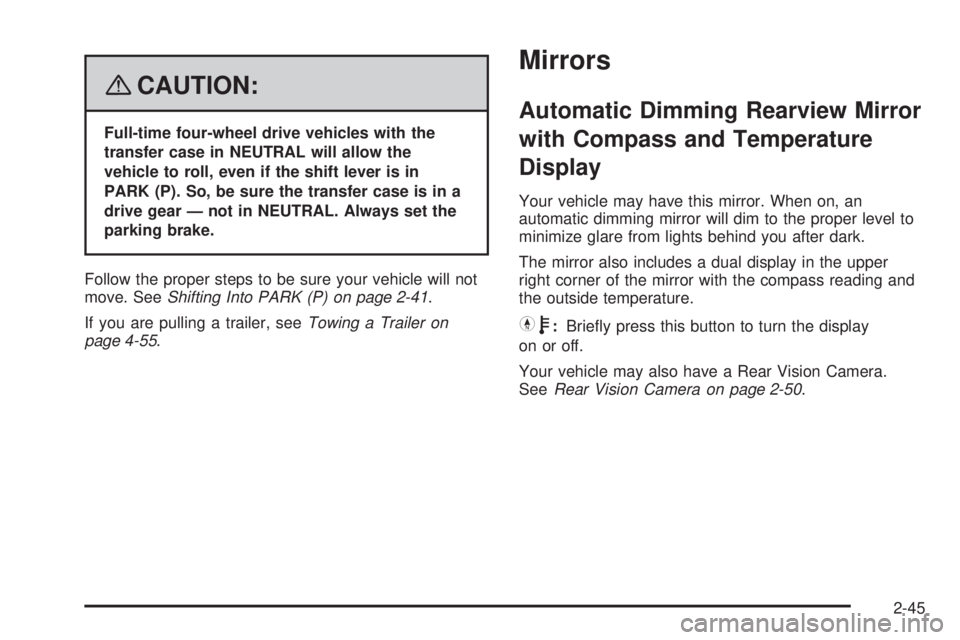
{CAUTION:
Full-time four-wheel drive vehicles with the
transfer case in NEUTRAL will allow the
vehicle to roll, even if the shift lever is in
PARK (P). So, be sure the transfer case is in a
drive gear — not in NEUTRAL. Always set the
parking brake.
Follow the proper steps to be sure your vehicle will not
move. SeeShifting Into PARK (P) on page 2-41.
If you are pulling a trailer, seeTowing a Trailer on
page 4-55.
Mirrors
Automatic Dimming Rearview Mirror
with Compass and Temperature
Display
Your vehicle may have this mirror. When on, an
automatic dimming mirror will dim to the proper level to
minimize glare from lights behind you after dark.
The mirror also includes a dual display in the upper
right corner of the mirror with the compass reading and
the outside temperature.
Yb:Brie�y press this button to turn the display
on or off.
Your vehicle may also have a Rear Vision Camera.
SeeRear Vision Camera on page 2-50.
2-45
Page 128 of 504

Automatic Dimming Mirror Operation
O
:Press this button to turn the automatic dimming
feature on or off. The indicator light to the left of
the button will turn on to indicate when the feature is on.
Once the mirror is turned off, it will remain off until it
is turned back on, or until the vehicle is restarted.
Temperature Display
The temperature can be displayed by pressing
the compass/temperature button. Pressing the
compass/temperature button once brie�y, will toggle
the temperature reading on and off. To alternate
the temperature reading between Fahrenheit and
Celsius, press and hold the compass/temperature
button for approximately four seconds until the
display blinks F and C. Press and release the
compass/temperature button to toggle between the
Fahrenheit and Celsius readings. After approximately
four seconds of inactivity, the display will stop blinking
and display the last selection made.
If an abnormal reading is displayed, for an extended
period of time, please consult your dealer/retailer.
Under certain circumstances, a delay in updating the
temperature is normal.
Compass Operation
Press the compass/temperature button once brie�y to
turn the compass on or off.
Compass Calibration
The compass may need calibration if the following occurs:
The compass does not display the correct heading
and the compass zone variance is set correctly.
In order to calibrate, CAL must be displayed in the
mirror compass windows. If CAL is not displayed, push
in the compass/temperature button for approximately
eight seconds or until CAL is displayed.
The compass can only be calibrated by driving the
vehicle forward in circles at 5 mph (8 km/h) or less until
the display reads a direction. Do not attempt to
calibrate the compass by driving in reverse.
2-46
Page 129 of 504
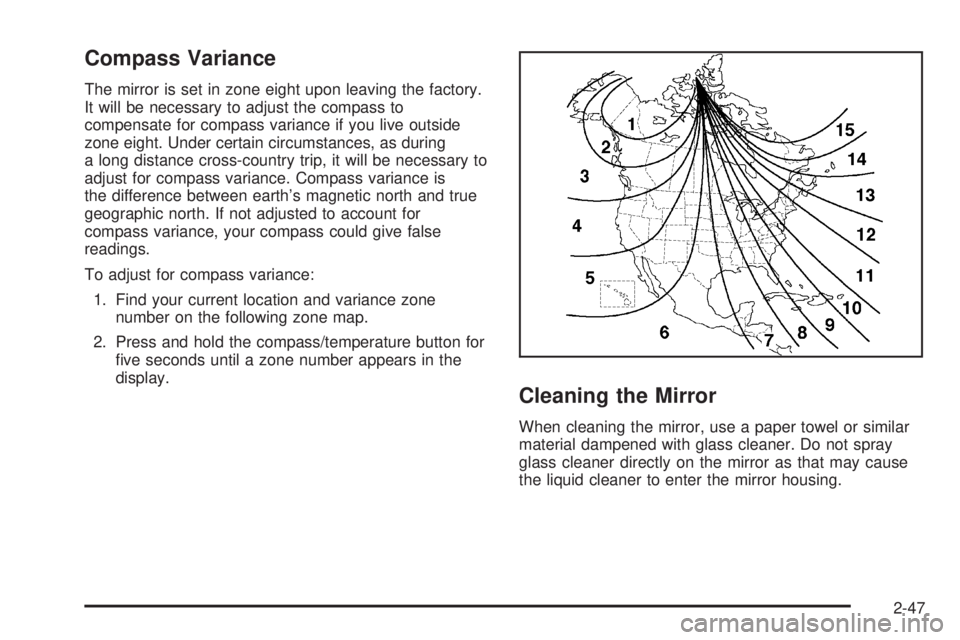
Compass Variance
The mirror is set in zone eight upon leaving the factory.
It will be necessary to adjust the compass to
compensate for compass variance if you live outside
zone eight. Under certain circumstances, as during
a long distance cross-country trip, it will be necessary to
adjust for compass variance. Compass variance is
the difference between earth’s magnetic north and true
geographic north. If not adjusted to account for
compass variance, your compass could give false
readings.
To adjust for compass variance:
1. Find your current location and variance zone
number on the following zone map.
2. Press and hold the compass/temperature button for
�ve seconds until a zone number appears in the
display.
Cleaning the Mirror
When cleaning the mirror, use a paper towel or similar
material dampened with glass cleaner. Do not spray
glass cleaner directly on the mirror as that may cause
the liquid cleaner to enter the mirror housing.
2-47
Page 131 of 504

Outside Automatic Dimming Mirror
If the vehicle has this feature, the driver’s outside mirror
adjusts for the glare of the headlamps behind you.
SeeAutomatic Dimming Rearview Mirror with Compass
and Temperature Display on page 2-45.
Park Tilt Mirrors
The vehicle’s outside mirrors can also perform a park tilt
function. This causes the passenger’s and/or driver’s
mirror to tilt to a preselected position when the vehicle is
in REVERSE (R). This feature may be useful in
viewing the curb when parallel parking.
When the vehicle is shifted out of REVERSE (R) and a
short delay has occurred, the passenger’s and/or
driver’s mirror will return to its original position.
To change the preselected tilt position, adjust the
mirrors to the desired position while the vehicle is in
REVERSE (R). When the vehicle is shifted out of
REVERSE (R), this new position is saved in memory as
the tilt position.
This feature can be enabled/disabled through the Driver
Information Center. SeeDIC Vehicle Customization
(With DIC Buttons) on page 3-63for more information.
Outside Convex Mirror
{CAUTION:
A convex mirror can make things (like other
vehicles) look farther away than they really are.
If you cut too sharply into the right lane, you
could hit a vehicle on your right. Check your
inside mirror or glance over your shoulder
before changing lanes.
The passenger side mirror is convex. A convex mirror’s
surface is curved so more can be seen from the
driver seat. It also makes things, like other vehicles,
look farther away than they really are.
Outside Heated Mirrors
The vehicle may have outside heated mirrors which
help clear them of condensation, snow, and ice.
When the rear window defogger button is pressed, the
heated mirrors are also turned on. See “Rear Window
Defogger” underDual Automatic Climate Control System
on page 3-22for more information.
2-49
Page 132 of 504

Object Detection Systems
Rear Vision Camera
Your vehicle may be equipped with a rear vision camera
system. Read this entire section before using the
camera system.
The rear vision camera system is designed to help
the driver when backing up by displaying a view of the
area behind the vehicle. When the driver shifts the
vehicle into REVERSE (R), the video screen will
automatically slide out from the rear view mirror.
Once the driver shifts out of REVERSE (R), the video
screen will slide back into the rear view mirror after
a delay.
If your vehicle does not have a rearview mirror slide-out
video screen, your vehicle may have a navigation
radio system. See the Navigation System manual for
more information on the rear vision camera display
video screen.
Turning the Rear Vision Camera System
On or Off
To turn off the rear vision camera system, do the
following:
1. Shift into (P) PARK.
2. Turn the ignition key to the RUN position.
3. Press the right button on the inside rear view mirror
brie�y; the right green light indicator will turn off.
The rear camera vision display is now disabled.
To turn on the rear camera vision feature again, press
the right button on the inside rear view mirror brie�y.
The green light indicator will illuminate. The rear camera
vision system is now enabled and the display will
slide out from the mirror normally.
2-50